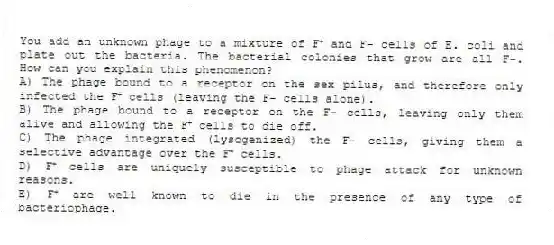
You add an unknown phage to a mixture of F⁺ and F− cells of E. coli and plate out the bacteria. The bacterial colonies that grow are all F−. How can you explain this phenomenon?
A) The phage bound to a receptor on the sex pilus, and therefore only infected the F⁺ cells (leaving the F− cells alone) .
B) The phage bound to a receptor on the F− cells, leaving only them alive and allowing the F⁺ cells to die off.
C) The phage integrated (lysogenized) the F− cells, giving them a selective advantage over the F⁺ cells.
D) F⁺ cells are uniquely susceptible to phage attack for unknown reasons.
E) F⁺ are well known to die in the presence of any type of bacteriophage.
Correct Answer:
Verified
Q106: Non-enveloped and enveloped viruses both may enter
Q107: Why is it not surprising that AIDS
Q108: Would you expect the number of virions
Q109: Spongiform encephalopathy occurs in all of the
Q110: Why are viroids resistant to nucleases?
A) Having
Q112: Capsids are made of a number of
Q113: Explain why HIV becomes resistant so quickly
Q114: An antibiotic is added to a culture
Q115: Bacteriophages, unlike animal viruses, often have special
Q116: Why do animal viruses have envelopes and
Unlock this Answer For Free Now!
View this answer and more for free by performing one of the following actions

Scan the QR code to install the App and get 2 free unlocks

Unlock quizzes for free by uploading documents